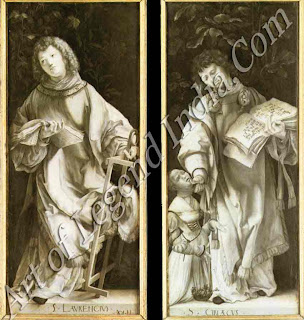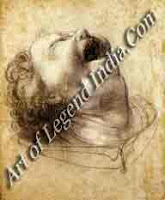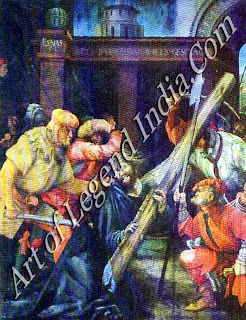Religious Visions
Neglected
for hundreds of years, Grunewald has now been recognised as a master. The
passion and intensity of his work gives powerful impact to his paintings, all
with religious themes.
Grunewald
is an isolated figure in the history of German art. His very individual style
of painting betrays no close allegiance to any of the masters of his age, he
left no known pupils or followers, and his descent into obscurity was both
rapid and complete. When, in 1597, Emperor Rudolph II tried to acquire The
Isenheim Altarpiece, the artist's identity was already unknown and, as late as
1852, The Miracle of the Snows was sold at a derisory price as a mediocre work
by an anonymous artist.
One
theory put forward to explain this neglect is that contemporary observers
deliberately ignored Grunewald because of his Lutheran beliefs. Much more
significant, however, was the fact that most unusually for this period he
produced little or no engraved work. In an age when travel was not always easy
and few people might, for example, be willing to risk a visit to a plague
hospital where The Isenheim Altarpiece was sited to see a work of art, this
drastically reduced the scope of his influence.
In
addition, Grunewald chose not to devote his studies to the new world of
possibilities that was being opened up by the Renaissance. His art was firmly centered
on God, not man. The small body of his surviving work is comprised entirely of
religious paintings, even though it is clear from his depiction of Cardinal
Albrecht as St Erasmus that he could have made a healthy living as a
portraitist. Certainly, he was aware of some of the technical developments
achieved by the Italians the laws of perspective and anatomy, in particular but
he used them only as minor components in his pictures.

Most of
Grunewald's commissions were for altarpieces. By the late Gothic period, these
had become complex but adaptable structures, in which the movable panels
enclosed sculpted figures and were crowned with richly carved canopies. The
painted sections included folding wings, which could be opened or shut to suit
the liturgical cycle of church feasts, and a detachable panel at the foot of
the picture, called a predella.
A COMPLEX MASTERPIECE
The
Isenheim Altarpiece was one of the most elaborate examples of this format ever
produced. The inner section, with its statues of saints by Niklaus von
Haguenau, was executed quite independently from Grunewald's contribution. His
work consisted of various panels including a double set of folding wings, which
allowed three separate combinations of pictures to be shown at different times
of year. Thus, the altarpiece would be closed during Easter week, when the
bleak Crucifixion symbolized the church's mourning; was opened for most of the
year, to show the joyous scenes of the Annunciation and the Resurrection; and
displayed the final variant, with incidents from the life of St Anthony, on the
feast day of the Order's patron saint.
The
status of artists at this time was that of craftsmen, rather than of creative
individuals. Patrons and especially religious patrons would choose the subjects
to be illustrated and would often sketch out a plan of the composition. Within
these restraints, however, Grunewald found a great deal of freedom to produce
his unique brand of expressive realism. 'A barbarian and a theologian', one
commentator called him, neatly identifying the contradictory strands of his
art.
Certain
Gothic elements remained in Grunewald's work. The use of a larger-than-life
Christ in scenes of the Passion was a distinctly medieval feature, and the
presence of John the Baptist at the Isenheim Crucifixion and the curious
angelic orchestra serenading the Virgin, proved that these were contemplative
works rather than naturalistic illustrations of Biblical events.
However,
Grunewald allied these intellectual compositions to an unprecedented show of
realism, in a bid to tie emotional and rational responses into a firm bond of
faith. To this end, he made use of expressionistic distortions to heighten the
graphic power of his paintings. In his Crucifixions, for example, Christ's feet
are stretched into a deformed arc; the fingers claw convulsively at the surrounding
blackness; and the flesh is livid, discoloured and flecked with thorny wounds.
The rough-surfaced beam of the cross is slightly curved and the arms of Christ
painfully rigid, so that the body looks like a helpless arrow on a giant bow.
EXPRESSIVE COLOURS
 An even
more potent weapon in Grunewald's artistic armoury was his vibrant colouring,
which could evoke the full gamut of human emotions, from the depths of despair
to the glory of the sublime. In all his versions of the Crucifixion, he
employed dark, sketchy backgrounds and pallid, bloodless figures, setting them
off with patches of incandescent colour, to create an eerie, mournful effect.
An even
more potent weapon in Grunewald's artistic armoury was his vibrant colouring,
which could evoke the full gamut of human emotions, from the depths of despair
to the glory of the sublime. In all his versions of the Crucifixion, he
employed dark, sketchy backgrounds and pallid, bloodless figures, setting them
off with patches of incandescent colour, to create an eerie, mournful effect.
By
contrast, his scenes of the Madonna and Child and the Annunciation glow with a
luminous joy, and the Isenheim Resurrection is a particular triumph. In most
contemporary treatments of this theme, Christ steps sedately out of his tomb
without waking the sleeping soldiers. In Grunewald's version, however, the
Saviour's Resurrection and his Ascension are combined in an explosion of light.
The guards are hurled aside like worthless dummies and Christ ascends to Heaven
encircled by a halo whose rainbow colours are reflected in his clothes.
Artists
usually prepared their own paints at this period, and were careful not to
divulge their methods. In later life, Grunewald was obliged to sell his paints
for a brief time and it is a measure of the quality of his colours that, after
his death in Halle, the city's official artist, Hans Hamburger, was called in
to analyze them. Unfortunately, he was unable to work out the formula and the
secret died with Grunewald.
Attempts
have been made to find an echo of Grunewald's individual style in the paintings
of his contemporaries of the Danube school. But the violence of Grunewald's
effects leaves them far behind and it is no accident that his work was
rediscovered in the 20th century, during the heyday of the German
Expressionists.
Writer
– Marshall Cavendish
 An even
more potent weapon in Grunewald's artistic armoury was his vibrant colouring,
which could evoke the full gamut of human emotions, from the depths of despair
to the glory of the sublime. In all his versions of the Crucifixion, he
employed dark, sketchy backgrounds and pallid, bloodless figures, setting them
off with patches of incandescent colour, to create an eerie, mournful effect.
An even
more potent weapon in Grunewald's artistic armoury was his vibrant colouring,
which could evoke the full gamut of human emotions, from the depths of despair
to the glory of the sublime. In all his versions of the Crucifixion, he
employed dark, sketchy backgrounds and pallid, bloodless figures, setting them
off with patches of incandescent colour, to create an eerie, mournful effect. 














0 Response to "German Great Artist Mathis Grunewald - Religious Visions "
Post a Comment